Taking Cover
Joe Dudziak keeps his head on a swivel as he drives along Santa Fe streets. He’s looking for people who would benefit from his help, even items as simple as a clean pair of socks, a package of batteries or a snack.His face and, more importantly, his compact SUV, are highly recognizable to many of the hundreds of unsheltered residents of Santa Fe who know him as Chaplain Joe and trust his street-based outreach efforts.
As he shows SFR some of the common spots for makeshift shelters, Dudziak says years ago he could easily spot groups of tents gathered together in mini communities, but a crackdown by the city and ever-expanding housing and business developments mean he has to stay on his toes to track folks down.
“They’re not even setting up camp anymore,” he says. “They’re just bedding down for the night and they get up in the morning and take all their stuff with them.”
During the height of the COVID-19 pandemic, the City of Santa Fe loosened its rules on public camping, allowing unhoused people to live openly in congregate settings. Then last year, officials said the grace period was over and hired park rangers to help clear out encampments. City staff next proposed creating a sanctioned camping space on the Midtown Campus, sparking intense debate about the future of the city-owned space and the impact on nearby neighborhoods, among other issues. After that proposal fell flat, the Community Health and Safety Department returned last month to the City Council with an alternative branded “safe outdoor space.”
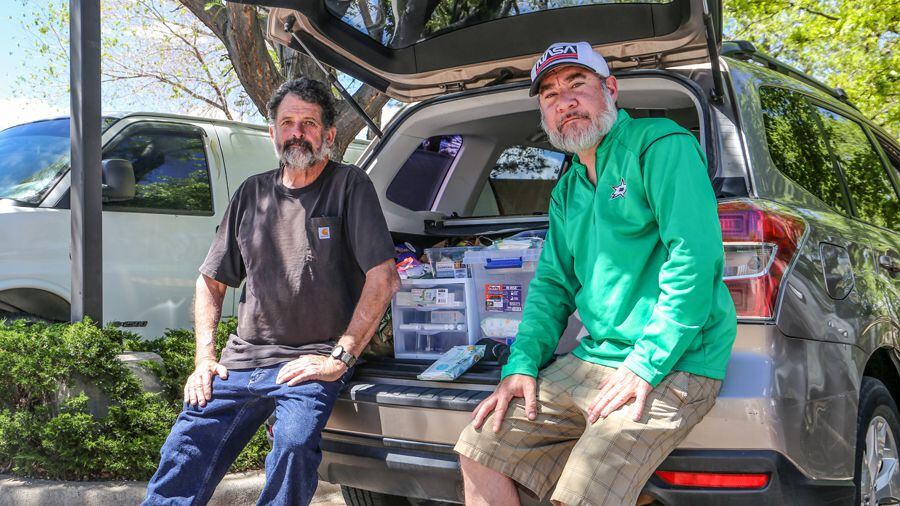
Left to right: Joe Dudziak and Doug Stuart spend their days cruising the city handing out supplies for those in need. (Andy Lyman/)
Councilors unanimously approved a resolution on April 26 to green-light a pilot plan that would use $1 million of remaining American Rescue Plan funds for capital and for the first year of operations to designate space for groups of small fiberglass and wood shelters equipped with heating, cooling and lighting. An estimated 25 so-called pop-up shelters or Pallet homes would be erected on land that also has bathrooms, showers and laundry machines.
The city’s latest gambit to address homelessness highlights the elusive nature of a solution to a growing local and national problem that intersects with a range of tough systemic challenges, including affordable housing, mental health and addiction.
In addition to funding programs at St. Elizabeth, the Interfaith Community Shelter and other community-led organizations, city leaders have taken on new projects to combat homelessness in the past several years by opening a Midtown Campus shelter and converting a former hotel into low-income housing. The Office of Affordable Housing and the Youth and Family Services Division combined have increased such spending–often through grants or other federal programs–from nearly $3 million in 2021 to more than $7 million last year. Advocates say the new plan to add another layer of housing will help to close gaps for those living on the streets. It’s intended to be a step up from camping and a safer alternative to people living in spaces like parks, trails and underpasses.
In order for the pilot to succeed, the city will need to find landowners willing to provide space and organizations to provide services for those who will use the shelters—partners to be solicited in a formal process set to begin by the end of the month. Next, those providers will need to convince people living in proximity to the shelters that their own lives won’t suffer as a result.
At a stoplight waiting to turn left on Cerrillos Road, Dudziak recognizes a man standing on the median, holding a cardboard sign that reads “Anything helps.”
Before the arrow turns green, he gives the man a small bag of snacks and a fresh pair of socks. After the man asks for a cigarette, Dudziak hands him two smokes from the pack bought with his own money.
Dudziak has been running his outreach program for the past four years and has been volunteering at shelters for nearly a decade. During those years, he’s come to know many people living on the streets and heard countless stories of struggles to even find work, let alone a place to stay.
He mostly interacts with folks who, for various reasons, can’t or won’t go to the handful of shelters around the city, each of which have their own requirements and standards. Current programs for people experiencing homelessness in Santa Fe range from those with easy access and limited stays to long-term housing with long wait lists and specific living requirements.
Consuelo’s Place at the Midtown Campus, for example, houses women and families. Santa Fe Suites, a former hotel the city helped convert to low-income apartments, offers monthly leases. The dorms at the Interfaith Community Shelter at Pete’s Place on Cerrillos Road and St. Elizabeth’s downtown provide emergency shelter. With each level of increased services and longer-term stays comes more requirements, such as staying sober or finding steady work. But many who benefit from Dudziak’s outreach are not ready to take that next step.
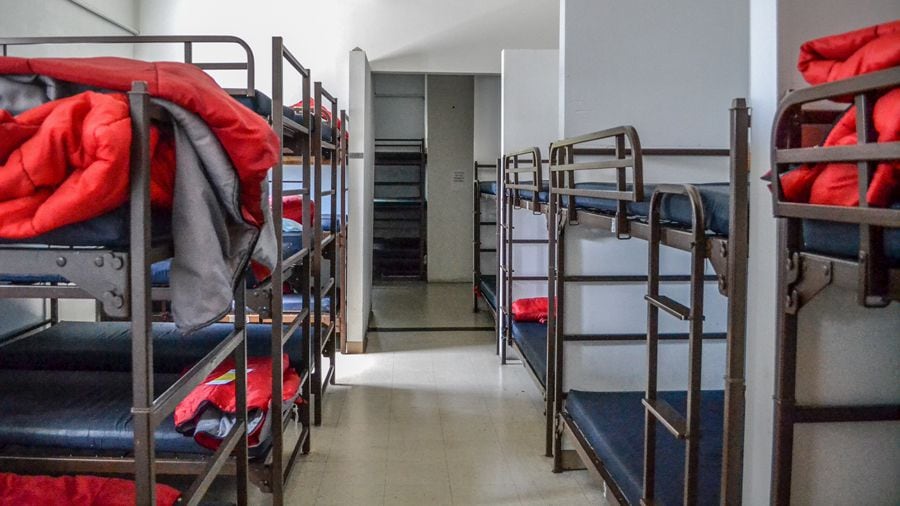
The Interfaith Community Shelter at Pete’s Place offers rows of bunk beds. (Andy Lyman/)
Some, Dudziak says, have behavioral health issues that make congregate settings difficult, while others might simply want a certain level of autonomy. He says connecting with the unhoused community has become increasingly hard as people spread out to avoid too much attention from police.
“It used to be encampments. Then it was onesies and twosies,” Dudziak says. “Now people are stashed in a group of piñon trees where they’re hidden away, where you can’t see them.”
Dudziak attributes the shift to the city’s park rangers, a relatively new addition to the city’s workforce that primarily serves as a non-law enforcement agency to keep people from camping in unauthorized places.
One of the spots that’s been intermittently popular for camping is the street outside the nonprofit shelter at Pete’s Place, a city-owned building. The general congregation of people in the area has led to mounting tension for years. Neighbors have raised concerns about blatant drug use and some joined with area business owners to file a lawsuit against the shelter nonprofit and the city for failing to address the problems.
During a May 4 virtual community engagement meeting aimed at connecting with residents who live nearby and have ongoing complaints about adjacent activities, Jason Sharp, a team lead with the park rangers, said when the city receives a report about encampments on city land, rangers ask people to clear out within 24 hours.
“A majority of the camps are referred to us through constituent services, but our rangers are out there proactively patrolling these areas and they’ll find new camps, they’ll patrol areas of camps that we’ve cleaned up before to ensure that the camps are not reestablished,” Sharp said.
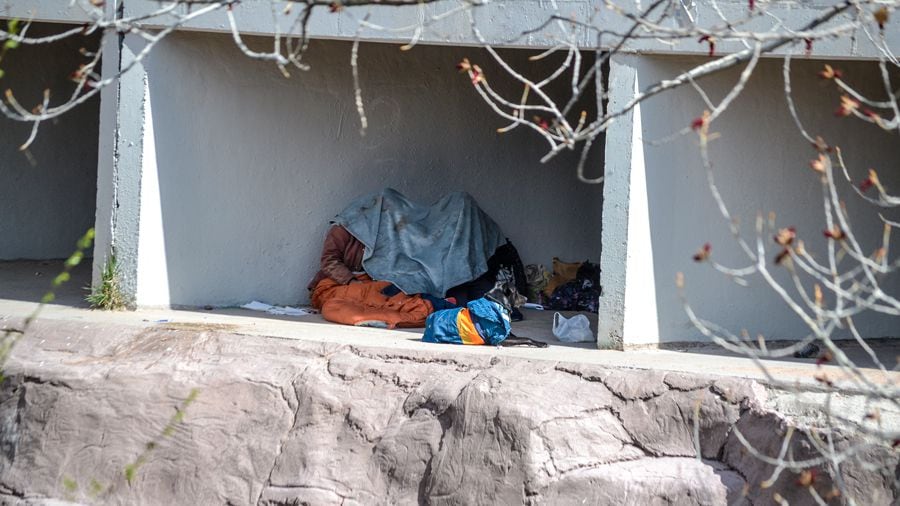
Unhoused people in Santa Fe often find hidden spots to sleep as a way to avoid attention from police and city rangers. (Andy Lyman/)
City of Santa Fe Youth and Family Services Division Director Julie Sanchez says the meeting previews what potential neighbors of the proposed shelters can expect to see once the city identifies locations. Part of the city’s resolution specifies that service providers will craft “good neighbor agreements” to include terms about communication, standards for tenancy and dispute resolution, among other topics.
“I think the neighbors would know what to expect and neighbors would know who to reach and contact when they had an issue,” Sanchez says. “I think there’d be a lot of accountability on both sides.”
Since the city is still in the beginning stages of rolling out the shelter pilot program and potential sites have not been publicly identified, it’s still too early to begin talks with nearby residents and businesses. Community Health and Safety Department Director Kyra Ochoa tells SFR she expects to issue the request for solicitations from qualifying charitable organizations that own adequate land this month. The organization or organizations awarded a contract would then begin outreach with surrounding communities.
Ochoa says some organizations have already shown interest in running the pilot program or providing land, but would not name them.
“We’re open minded. We really haven’t predetermined this at all. We’re really curious to see who does apply,” Ochoa says. “We know there’s a lot of interest that’s been expressed. Sometimes there’s a gap between the interest that is expressed and the work that’s required to reply to a solicitation like this.”
Marisol Atkins, a consultant for the S3 Santa Fe Housing Initiative—which includes Santa Fe County, the City of Santa Fe, Anchorum St. Vincent, Thornburg Foundation, the McCune Charitable Trust, Santa Fe Community Foundation and New Mexico Coalition to End Homelessness—says many organizations are keeping their intentions quiet until the city issues its request.
“There’s some potential faith-based interest for the site, and then there’s some local service providers I’m aware of who are considering applications as well,” Atkins says.
Ochoa and her staff hit a roadblock last year when they proposed using the Midtown Campus as a sanctioned camping site after staff evaluated over 100 potential city-owned tracts. Area residents said at the time sanctioned camping at the already established shelter would have been too close to public spaces and would be a danger to nearby children.
Until the ball gets rolling it’s also unclear what will be required of residents in terms of length of stays or behavior-based rules such as drug or alcohol policies. The proposed shelters—small, one-room buildings designed to sleep one to two people—can accommodate pets, which aren’t allowed in most other shelter settings.
Cities such as Las Cruces and Albuquerque have each tried to roll out designated areas for makeshift shelters, with mixed results. Las Cruces officials successfully paved the way for Camp Hope, an outdoor shelter area overseen by a local nonprofit. But Albuquerque officials are still struggling to gain full-fledged support for a similar proposal. Similar shelters to those the City of Santa Fe plans to buy have been erected in a handful of areas in Colorado, including the Beloved Community Village in Denver, cited in the city’s resolution.
Across the nation, cities struggle for the best ways to end—or at least curb—homelessness. Many have landed on the dual strategy of clearing encampments and providing services at sanctioned places for shelter. Los Angeles has taken steps to transition tent dwellers into hotel rooms, similar to efforts in other cities such as Portland.
Dudziak and Doug Stuart, who rides shotgun, believe the pilot program will help alleviate concerns raised during the online meeting. The city’s resolution says the new site or sites would have shower and bathroom facilities, which Dudziak and Stuart note would help keep streets and sidewalks clean.
Stuart says the shelters would be another tool on the way to a more permanent solution for each person.
“You have all these little micro cultures,” Stuart says. “People who want to be loners, people who want to be in a camp, people who want to be in a shelter, people who are looking for housing, people who want jobs. There’s all these dynamics that happen with all these different people.”
As Dudziak drives down Cerillos and past Pete’s Place, people sitting on the curb with carts and tents in tow partly line the adjacent Harrison Road. A few minutes later and less than a mile from Pete’s Place, Dudziak spots a familiar face squatting down in the corner of a motel parking lot “smoking blues,” or illicit-market fentanyl.
Such scenes likely stoke anxiety for would-be neighbors of the proposed shelter area, yet Sanchez says the community can find middle ground with the right approach.
She believes one key to a successful safe sleeping space can be in making it as easy as possible for unhoused people with substance abuse issues to move into one of the pop up shelters.
“I hope that whatever operator, whatever service provider responds to this solicitation will make it so it’s not a barrier for individuals accessing that space, making it safe for everybody,” Sanchez says.
Still, she acknowledges that low barriers might be a tough sell.
“It is going to be a heavy lift for any organization doing this,” she says. “But I think starting early around education, understanding and then creating those expectations will reduce the amount of headache for both the provider and the neighbors.”
In the year Korina Lopez has served as full-time executive director of the Interfaith Community Shelter at Pete’s Place, as well as during her prior experience as director of the Midtown Consuela’s Place, she has seen and heard a lot about the need for additional services and shelters.
She says taking on the job of running a new safe outdoor space is something her organization is “very much interested in.”
“Obviously, we’re going to wait for the proposal, and then of course, location, location, location,” Lopez tells SFR. “I mean, that is our population.”
The shelter at Pete’s Place has a relatively low-barrier to entry. That means residents have a place to sleep as long as they get to the shelter in time to snag a bed, don’t use drugs or alcohol on site and generally don’t cause problems. Once they check in and shuffle past the shower facilities that are available three days a week, people can choose one of the 123 tri-level bunk beds for the night. The shelter offers “resource days” Tuesdays, Wednesdays and Fridays for showers, laundry and case management appointments.
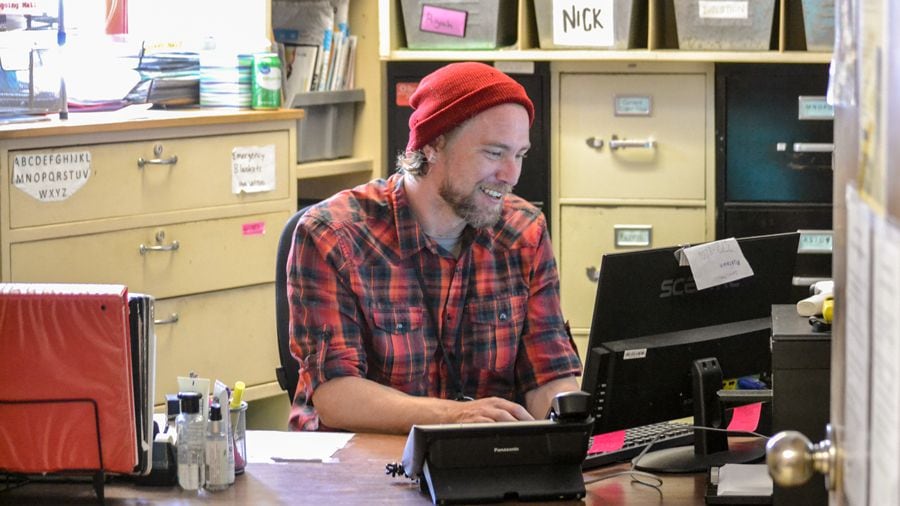
Jeremy Ladner, who was nearly homeless, now works the intake desk at St. Elizabeth’s men’s emergency shelter. (Andy Lyman/)
Prior to this year, the shelter was open overnight for men and women only during the winter months, but allowed women overnight during the summer. This year, due to the city cracking down on public camping, it will be open overnight all year for everyone.
Lopez says before the COVID-19 pandemic, the shelter was typically at full capacity on most nights. During the recent winter months, she says, about 80 people would stay each night.
The proliferation of fentanyl has fueled a change in how people use the facility, she says, noting that back in the day, those addicted to heroin could get one last fix in before bunking down for the night, but fentanyl wears off much quicker.
“What we see a lot is people will either just book it because they’re like, ‘I can’t go into withdrawal,’ or, people will try to sneak stuff in and use, and we’re like, ‘Hey, you can’t use on this site,’” she says, adding staff will often try to help with treatment options but that success is “hit or miss.”
Santa Fe Police Captain Anthony Tapia tells SFR it’s mostly up to individual officers to decide what to do when they encounter someone who’s illegally camping on city property, such as the streets surrounding Pete’s Place.
“Generally, officers aren’t just going to pull up and arrest everybody who’s hanging out there on the sidewalk,” Tapia says. “We’re going to try and work it out so they can move on and [officers will] explain to them where they can hang out.”
Lopez tells SFR her staff can’t do much about situations occurring beyond the shelter’s wrought iron fence, but the staff sometimes allows people to congregate under the facility’s covered patio area.
“If you’re not getting into arguments and there’s no issues, if people can be chill and relaxed, we’re not gonna run them off,” she says.
The public testimony of several people at a recent City Council meeting, however, contrasts the frustrations of some of Pete’s Place neighbors. Residents of other areas of the city said they would welcome a safe outdoor sleeping space in their neighborhoods.
Kevin Rapp, a recent transplant from Colorado, told the panel during an April 26 meeting that after seeing a similar program outside Denver, he’s all for it in Santa Fe.
“I would much rather have [a safe outdoor space] with all the services and all the support that goes with that than to have people just camping randomly that you don’t know who they are,” Rapp said.
About 3 miles north of Pete’s Place and on the edge of downtown, St. Elizabeth’s men’s shelter accommodates 28 overnight guests and also serves as the nonprofit’s main office. St. Elizabeth’s has a perpetual waitlist, but provides more stable housing in the way of a separate family shelter and an apartment complex with 160 units, each also with their own waitlists.
Executive Director Edward Archuleta, who has served in nearly every staff role over a span of more than a decade, says the pilot probably won’t impact St. Elizabeth’s waiting list notably, but would provide an alternative for some.
“Folks who want to stay in the [new shelters] aren’t the ones who want to come here,” he says.
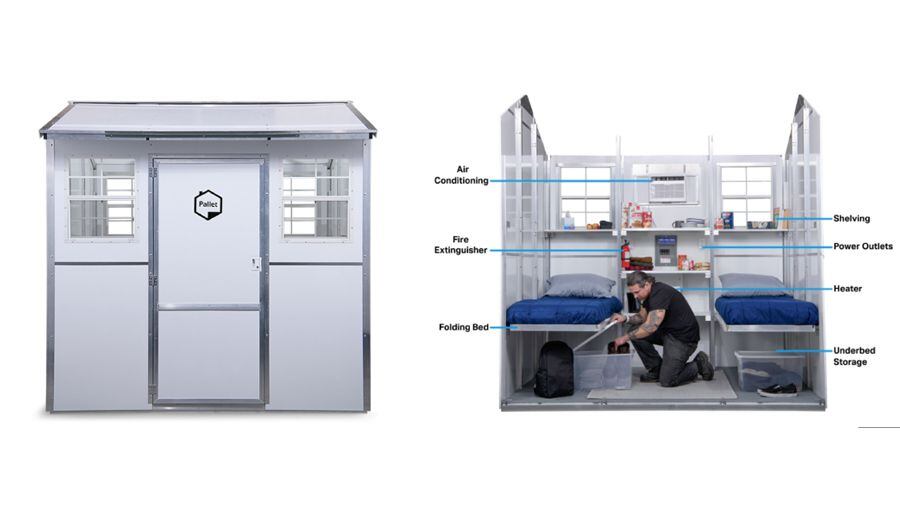
Pallet offers modest, two-person shelters similar those the city plans to buy. (Courtesy palletshelter.com/)
Cara Latil, who oversees St. Elizabeth’s Casa Familia shelter for women and families, says there have been a few instances of people trying their best to make it at the family shelter, but that single women don’t always want to be around families with young children and will find other accommodations.
“Sometimes it will last for a while, but then they’ll come to a point where they’re like, ‘Okay, I’m done,’” Latil says.
St. Elizabeth provides a longer term option for those who qualify, but also requires residents leave during the day for work or to look for a job unless they’re sick. The goal is to get people back on their feet.
Jeremy Ladner, a live-in volunteer intern, is usually the one who darts back and forth between the front desk and the front door, responding to the call button outside. In between stamping incoming mail and answering the phone and door, Ladner tells SFR he was on the verge of being homeless when he recently moved to Santa Fe until he managed to snag a bed at St. Elizabeth’s.
“I was basically just in between where I was staying and needing somewhere to stay,” he says.
Ladner says he hasn’t experienced living on the streets, but says he’s come to know many unhoused people in downtown Santa Fe through his trips to the skate park.
“I think it’s important that the city recognizes the problem that we have, and that there needs to be something done,” Ladner says.
He attributes the high cost of living in Santa Fe as one reason people can quickly fall into a situation where they don’t know where they might sleep or get their next meal.
“If you need to get out of where you’re staying and you don’t have money for your first and last month’s rent at a place at a really high rate, it’s not easy,” he says.
The city’s most recent “point in time” count estimated in January some 260 people are experiencing homelessness, and insiders say that’s likely a low figure. Archuleta, Lopez and Dudziak agree that the new shelters will probably not end homelessness in Santa Fe, but will fill in some gaps, even if the process seems slow moving.
“It’s not the solution,” Duziak says. “But it’s a piece of the puzzle. There’s not one size fits all.”
